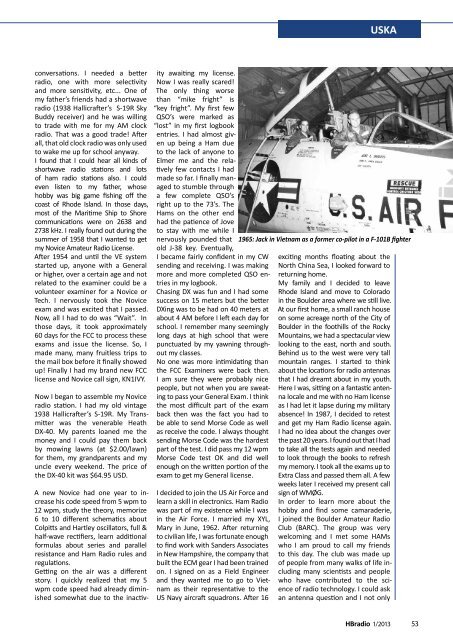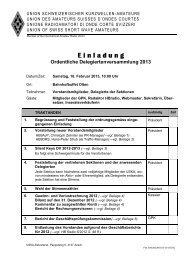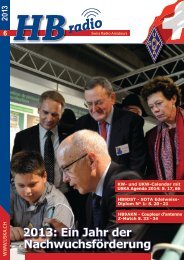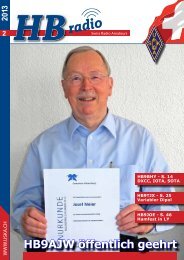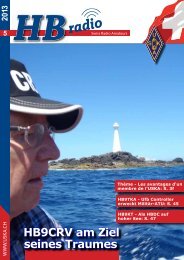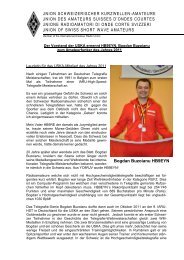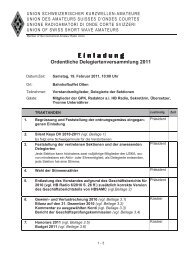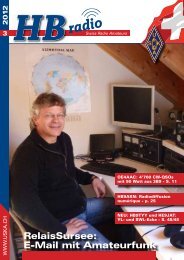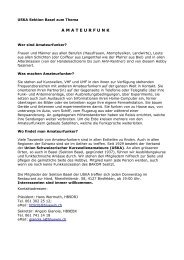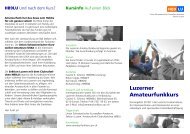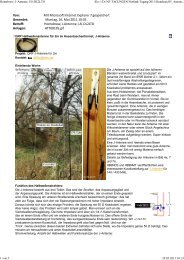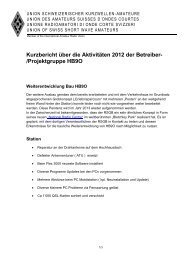Sie wollen auch ein ePaper? Erhöhen Sie die Reichweite Ihrer Titel.
YUMPU macht aus Druck-PDFs automatisch weboptimierte ePaper, die Google liebt.
<strong>USKA</strong><br />
conversations. I needed a better<br />
radio, one with more selectivity<br />
and more sensitivity, etc... One of<br />
my father’s friends had a shortwave<br />
radio (1938 Hallicrafter’s S-19R Sky<br />
Buddy receiver) and he was willing<br />
to trade with me for my AM clock<br />
radio. That was a good trade! After<br />
all, that old clock radio was only used<br />
to wake me up for school anyway.<br />
I found that I could hear all kinds of<br />
shortwave radio stations and lots<br />
of ham radio stations also. I could<br />
even l<strong>ist</strong>en to my father, whose<br />
hobby was big game fishing off the<br />
coast of Rhode Island. In those days,<br />
most of the Maritime Ship to Shore<br />
communications were on 2638 and<br />
2738 kHz. I really found out during the<br />
summer of 1958 that I wanted to get<br />
my Novice Amateur Radio License.<br />
After 1954 and until the VE system<br />
started up, anyone with a General<br />
or higher, over a certain age and not<br />
related to the examiner could be a<br />
volunteer examiner for a Novice or<br />
Tech. I nervously took the Novice<br />
exam and was excited that I passed.<br />
Now, all I had to do was “Wait”. In<br />
those days, it took approximately<br />
60 days for the FCC to process these<br />
exams and issue the license. So, I<br />
made many, many fruitless trips to<br />
the mail box before it finally showed<br />
up! Finally I had my brand new FCC<br />
license and Novice call sign, KN1IVY.<br />
Now I began to assemble my Novice<br />
radio station. I had my old vintage<br />
1938 Hallicrafter’s S-19R. My Transmitter<br />
was the venerable Heath<br />
DX-40. My parents loaned me the<br />
money and I could pay them back<br />
by mowing lawns (at $2.00/lawn)<br />
for them, my grandparents and my<br />
uncle every weekend. The price of<br />
the DX-40 kit was $64.95 USD.<br />
A new Novice had one year to increase<br />
his code speed from 5 wpm to<br />
12 wpm, study the theory, memorize<br />
6 to 10 different schematics about<br />
Colpitts and Hartley oscillators, full &<br />
half-wave rectifiers, learn additional<br />
formulas about series and parallel<br />
res<strong>ist</strong>ance and Ham Radio rules and<br />
regulations.<br />
Getting on the air was a different<br />
story. I quickly realized that my 5<br />
wpm code speed had already diminished<br />
somewhat due to the inactivity<br />
awaiting my license.<br />
Now I was really scared!<br />
The only thing worse<br />
than “mike fright” is<br />
“key fright”. My first few<br />
QSO’s were marked as<br />
“lost” in my first logbook<br />
entries. I had almost given<br />
up being a Ham due<br />
to the lack of anyone to<br />
Elmer me and the relatively<br />
few contacts I had<br />
made so far. I finally managed<br />
to stumble through<br />
a few complete QSO’s<br />
right up to the 73’s. The<br />
Hams on the other end<br />
had the patience of Jove<br />
to stay with me while I<br />
nervously pounded that<br />
old J-38 key. Eventually,<br />
I became fairly confident in my CW<br />
sending and receiving. I was making<br />
more and more completed QSO entries<br />
in my logbook.<br />
Chasing DX was fun and I had some<br />
success on 15 meters but the better<br />
DXing was to be had on 40 meters at<br />
about 4 AM before I left each day for<br />
school. I remember many seemingly<br />
long days at high school that were<br />
punctuated by my yawning throughout<br />
my classes.<br />
No one was more intimidating than<br />
the FCC Examiners were back then.<br />
I am sure they were probably nice<br />
people, but not when you are sweating<br />
to pass your General Exam. I think<br />
the most difficult part of the exam<br />
back then was the fact you had to<br />
be able to send Morse Code as well<br />
as receive the code. I always thought<br />
sending Morse Code was the hardest<br />
part of the test. I did pass my 12 wpm<br />
Morse Code test OK and did well<br />
enough on the written portion of the<br />
exam to get my General license.<br />
I decided to join the US Air Force and<br />
learn a skill in electronics. Ham Radio<br />
was part of my ex<strong>ist</strong>ence while I was<br />
in the Air Force. I married my XYL,<br />
Mary in June, 1962. After returning<br />
to civilian life, I was fortunate enough<br />
to find work with Sanders Associates<br />
in New Hampshire, the company that<br />
built the ECM gear I had been trained<br />
on. I signed on as a Field Engineer<br />
and they wanted me to go to Vietnam<br />
as their representative to the<br />
US Navy aircraft squadrons. After 16<br />
1965: Jack in Vietnam as a former co-pilot in a F-101B fighter<br />
exciting months floating about the<br />
North China Sea, I looked forward to<br />
returning home.<br />
My family and I decided to leave<br />
Rhode Island and move to Colorado<br />
in the Boulder area where we still live.<br />
At our first home, a small ranch house<br />
on some acreage north of the City of<br />
Boulder in the foothills of the Rocky<br />
Mountains, we had a spectacular view<br />
looking to the east, north and south.<br />
Behind us to the west were very tall<br />
mountain ranges. I started to think<br />
about the locations for radio antennas<br />
that I had dreamt about in my youth.<br />
Here I was, sitting on a fantastic antenna<br />
locale and me with no Ham license<br />
as I had let it lapse during my military<br />
absence! In 1987, I decided to retest<br />
and get my Ham Radio license again.<br />
I had no idea about the changes over<br />
the past 20 years. I found out that I had<br />
to take all the tests again and needed<br />
to look through the books to refresh<br />
my memory. I took all the exams up to<br />
Extra Class and passed them all. A few<br />
weeks later I received my present call<br />
sign of WMØG.<br />
In order to learn more about the<br />
hobby and find some camaraderie,<br />
I joined the Boulder Amateur Radio<br />
Club (BARC). The group was very<br />
welcoming and I met some HAMs<br />
who I am proud to call my friends<br />
to this day. The club was made up<br />
of people from many walks of life including<br />
many scient<strong>ist</strong>s and people<br />
who have contributed to the science<br />
of radio technology. I could ask<br />
an antenna question and I not only<br />
HBradio 1/2013 53


